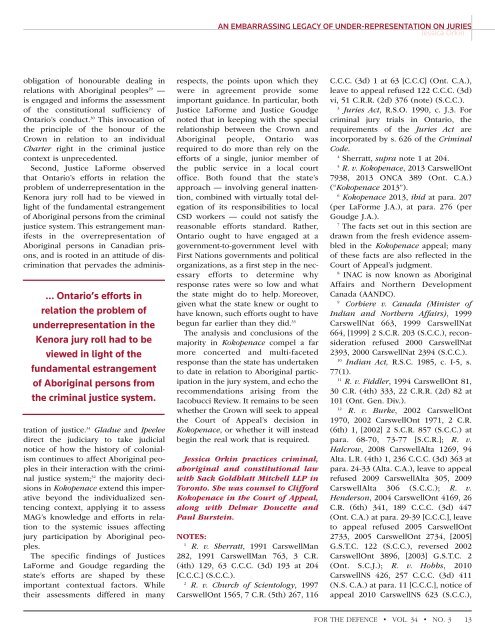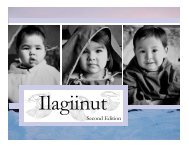FTD_Vol34_No3_web
FTD_Vol34_No3_web
FTD_Vol34_No3_web
Create successful ePaper yourself
Turn your PDF publications into a flip-book with our unique Google optimized e-Paper software.
For the Defence_34-3_Layout 1 13-08-16 10:40 AM Page 13<br />
AN EMBARRASSING LEGACY OF UNDER-REPRESENTATION ON JURIES<br />
... Ontario’s efforts in<br />
relation the problem of<br />
underrepresentation in the<br />
Kenora jury roll had to be<br />
viewed in light of the<br />
fundamental estrangement<br />
of Aboriginal persons from<br />
the criminal justice system.<br />
obligation of honourable dealing in<br />
relations with Aboriginal peoples 29 —<br />
is engaged and informs the assessment<br />
of the constitutional sufficiency of<br />
Ontario’s conduct. 30 This invocation of<br />
the principle of the honour of the<br />
Crown in relation to an individual<br />
Charter right in the criminal justice<br />
context is unprecedented.<br />
Second, Justice LaForme observed<br />
that Ontario’s efforts in relation the<br />
problem of underrepresentation in the<br />
Kenora jury roll had to be viewed in<br />
light of the fundamental estrangement<br />
of Aboriginal persons from the criminal<br />
justice system. This estrangement manifests<br />
in the overrepresentation of<br />
Aboriginal persons in Canadian prisons,<br />
and is rooted in an attitude of discrimination<br />
that pervades the administration<br />
of justice. 31 Gladue and Ipeelee<br />
direct the judiciary to take judicial<br />
notice of how the history of colonialism<br />
continues to affect Aboriginal peoples<br />
in their interaction with the criminal<br />
justice system; 32 the majority decisions<br />
in Kokopenace extend this imperative<br />
beyond the individualized sentencing<br />
context, applying it to assess<br />
MAG’s knowledge and efforts in relation<br />
to the systemic issues affecting<br />
jury participation by Aboriginal peoples.<br />
The specific findings of Justices<br />
LaForme and Goudge regarding the<br />
state’s efforts are shaped by these<br />
important contextual factors. While<br />
their assessments differed in many<br />
respects, the points upon which they<br />
were in agreement provide some<br />
important guidance. In particular, both<br />
Justice LaForme and Justice Goudge<br />
noted that in keeping with the special<br />
relationship between the Crown and<br />
Aboriginal people, Ontario was<br />
required to do more than rely on the<br />
efforts of a single, junior member of<br />
the public service in a local court<br />
office. Both found that the state’s<br />
approach — involving general inattention,<br />
combined with virtually total delegation<br />
of its responsibilities to local<br />
CSD workers — could not satisfy the<br />
reasonable efforts standard. Rather,<br />
Ontario ought to have engaged at a<br />
government-to-government level with<br />
First Nations governments and political<br />
organizations, as a first step in the necessary<br />
efforts to determine why<br />
response rates were so low and what<br />
the state might do to help. Moreover,<br />
given what the state knew or ought to<br />
have known, such efforts ought to have<br />
begun far earlier than they did. 33<br />
The analysis and conclusions of the<br />
majority in Kokopenace compel a far<br />
more concerted and multi-faceted<br />
response than the state has undertaken<br />
to date in relation to Aboriginal participation<br />
in the jury system, and echo the<br />
recommendations arising from the<br />
Iacobucci Review. It remains to be seen<br />
whether the Crown will seek to appeal<br />
the Court of Appeal’s decision in<br />
Kokopenace, or whether it will instead<br />
begin the real work that is required.<br />
Jessica Orkin practices criminal,<br />
aboriginal and constitutional law<br />
with Sack Goldblatt Mitchell LLP in<br />
Toronto. She was counsel to Clifford<br />
Kokopenace in the Court of Appeal,<br />
along with Delmar Doucette and<br />
Paul Burstein.<br />
NOTES:<br />
1<br />
R. v. Sherratt, 1991 CarswellMan<br />
282, 1991 CarswellMan 763, 3 C.R.<br />
(4th) 129, 63 C.C.C. (3d) 193 at 204<br />
[C.C.C.] (S.C.C.).<br />
2<br />
R. v. Church of Scientology, 1997<br />
CarswellOnt 1565, 7 C.R. (5th) 267, 116<br />
C.C.C. (3d) 1 at 63 [C.C.C] (Ont. C.A.),<br />
leave to appeal refused 122 C.C.C. (3d)<br />
vi, 51 C.R.R. (2d) 376 (note) (S.C.C.).<br />
3<br />
Juries Act, R.S.O. 1990, c. J.3. For<br />
criminal jury trials in Ontario, the<br />
requirements of the Juries Act are<br />
incorporated by s. 626 of the Criminal<br />
Code.<br />
4<br />
Sherratt, supra note 1 at 204.<br />
5<br />
R. v. Kokopenace, 2013 CarswellOnt<br />
7938, 2013 ONCA 389 (Ont. C.A.)<br />
(“Kokopenace 2013”).<br />
6<br />
Kokopenace 2013, ibid at para. 207<br />
(per LaForme J.A.), at para. 276 (per<br />
Goudge J.A.).<br />
7<br />
The facts set out in this section are<br />
drawn from the fresh evidence assembled<br />
in the Kokopenace appeal; many<br />
of these facts are also reflected in the<br />
Court of Appeal’s judgment.<br />
8<br />
INAC is now known as Aboriginal<br />
Affairs and Northern Development<br />
Canada (AANDC).<br />
9<br />
Corbiere v. Canada (Minister of<br />
Indian and Northern Affairs), 1999<br />
CarswellNat 663, 1999 CarswellNat<br />
664, [1999] 2 S.C.R. 203 (S.C.C.), reconsideration<br />
refused 2000 CarswellNat<br />
2393, 2000 CarswellNat 2394 (S.C.C.).<br />
10<br />
Indian Act, R.S.C. 1985, c. I-5, s.<br />
77(1).<br />
11<br />
R. v. Fiddler, 1994 CarswellOnt 81,<br />
30 C.R. (4th) 333, 22 C.R.R. (2d) 82 at<br />
101 (Ont. Gen. Div.).<br />
12<br />
R. v. Burke, 2002 CarswellOnt<br />
1970, 2002 CarswellOnt 1971, 2 C.R.<br />
(6th) 1, [2002] 2 S.C.R. 857 (S.C.C.) at<br />
para. 68-70, 73-77 [S.C.R.]; R. v.<br />
Halcrow, 2008 CarswellAlta 1269, 94<br />
Alta. L.R. (4th) 1, 236 C.C.C. (3d) 363 at<br />
para. 24-33 (Alta. C.A.), leave to appeal<br />
refused 2009 CarswellAlta 305, 2009<br />
CarswellAlta 306 (S.C.C.); R. v.<br />
Henderson, 2004 CarswellOnt 4169, 26<br />
C.R. (6th) 341, 189 C.C.C. (3d) 447<br />
(Ont. C.A.) at para. 29-39 [C.C.C.], leave<br />
to appeal refused 2005 CarswellOnt<br />
2733, 2005 CarswellOnt 2734, [2005]<br />
G.S.T.C. 122 (S.C.C.), reversed 2002<br />
CarswellOnt 3896, [2003] G.S.T.C. 2<br />
(Ont. S.C.J.); R. v. Hobbs, 2010<br />
CarswellNS 426, 257 C.C.C. (3d) 411<br />
(N.S. C.A.) at para. 11 [C.C.C.], notice of<br />
appeal 2010 CarswellNS 623 (S.C.C.),<br />
FOR THE DEFENCE • VOL. 34 • NO. 3<br />
13



